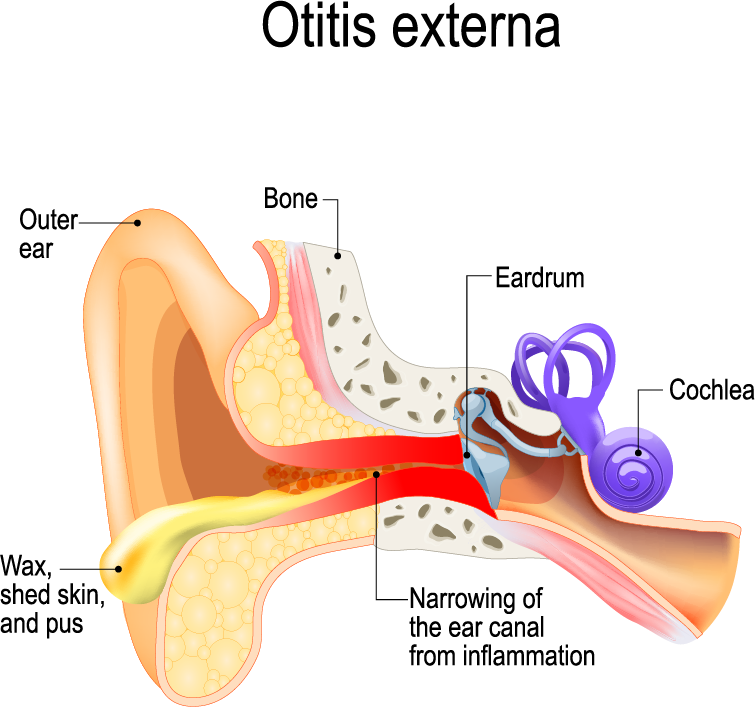Conditions: Ear Infections
Otitis media (middle ear infection)
Sometimes mistakenly called an “inner ear infection,” otitis media is the common type of infection behind the ear drum. It is often very painful and associated with hearing loss. It can happen at any time, but is more likely after infection in the nose or throat or if there is a hole (perforation) in the ear drum, as examples. Without a perforation in the ear drum, pressure can build and pain is typical; with a perforation, the pus can drain out through the hole and the ear canal and become visible. Recurrent middle ear infections, a prolonged middle ear infection, or a very severe (complicated) infection benefit from evaluation and treatment by an ear, nose, and throat doctor. See Eustachian tube dysfunction and its treatment.
otitis externa (swimmer’s ear)
Otitis externa is an infection of the ear canal itself. It is called swimmer’s ear because significant water exposure is a risk factor for its development, but moisture in general (including hot-tubbing, water retained in the ear canals after showering, or humid environments) and not just swimming is predisposing. Having diabetes, using Q-tips in the ear, and prolonged usage of a hearing aid are also risk factors for otitis externa.
Sudden sensorineural hearing loss
Sudden hearing loss requires evaluation. Fortunately the vast majority of sudden hearing losses are due to something disrupting the mechanical conduction of sound energy to the inner ear. In the minority of cases when the cause of sudden hearing loss is found to be a problem with the inner ear, urgent measures are taken. An infection of the cochlea (hearing part of the inner ear) is one relatively frequent cause of sudden inner ear (sensorineural) hearing loss, and timely treatment is needed to minimize any permanent hearing loss. Other causes of sudden sensorineural hearing loss include Meniere’s disease and a type of benign tumor (acoustic schwannoma) that pinches the hearing nerve. These are part of the evaluation, but the timeliness of the infectious cause drives the urgency of this condition.
Cholesteatoma
Cholesteatoma is a destructive and expanding growth consisting of skin cells (keratinizing squamous epithelium) in the middle ear and/or mastoid. Cholesteatomas are not tumors or cancerous as the name may suggest, but can cause significant problems because they expand in size and erode through nearby structures. This can result in the destruction of the bones of the middle ear (ossicles), as well as growth through the skull base into the brain. They often become infected and can result in chronically draining ears. Treatment almost always consists of surgical removal.
Labyrinthitis
Fortunately rare, infection of the inner ear can cause permanent injury to the hearing and balance systems. Note that people sometimes use the term “inner ear infection” when they mean “middle ear infection” which is far more common. The labyrinth is the part of the inner ear dedicated to rotational sensation, and an infection here can cause severe spinning vertigo, rapid eye movements (nystagmus), along with nausea. Viruses (such as herpes simplex virus-1) or bacteria are among the infectious causes of labyrinthitis. Other causes of inflammation in the inner ear labyrinth that are not infectious include pressure changes (such as with scuba diving or flying) or lack of blood flow (ischemia).
Perichondritis. Note the lack of red coloration to the ear lobe, which has no cartilage. Photo credit: Welleschik.
Auricular cellulitis, perichondritis, and chondritis
The outer ear (auricle or pinna) is composed of layers of skin and cartilage, with a thin covering between the skin and cartilage called perichondrium. skin and cartilage. Of course, any of those layers could become infected. When raised fluid filled blisters (vesicles) are present, a viral cause is considered. When most of the the outer ear is red, swollen, and tender, but the ear lobe is normal, one thinks of infection of the cartilage or the perichondrium and this is usually bacterial.
Temporo-Mandibular Joint Pain
While not an infection, ear pain caused by the temporo-mandibular joint (TMJ) is commonly assumed to be infection at first. The jaw joint, directly in front of the ear canal, commonly is the source of ear pain in the general population. Additional information may be found in this link from ENTHealth.org. A dentist with a focus on the TMJ is the usual treating provider.
how to get the most from your EAR appointment
Appointment time is valuable. Here are some suggestions to make the most of your appointment. This preparation will help you and your doctor maximize efficiency and accuracy, freeing up time for questions and answers.









